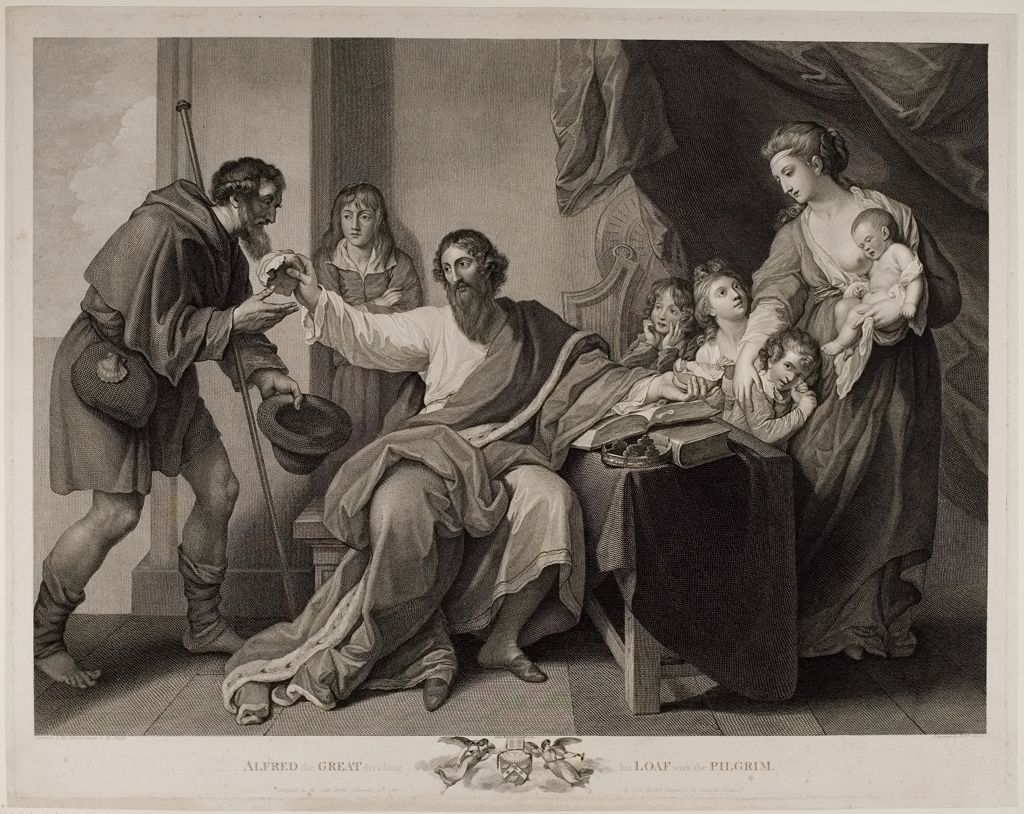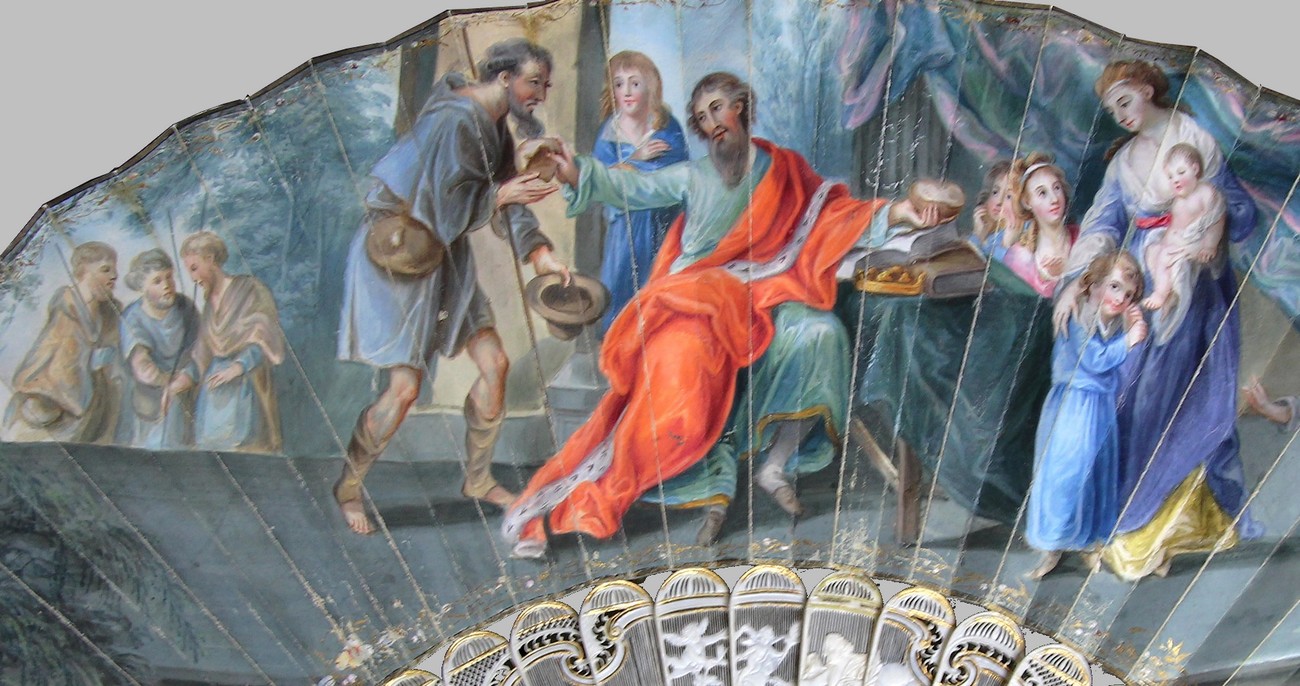|
|
|
|
The fan we are going to study now was presented at the sale of Eventails VI (Rossini, Me Deburaux, Expert Saboudjian) on 30 May 2002 with the following description:
Lot 61 "Symbol of the Eucariste" Fan, the vellum leaf painted in gouache of a scene where Christ in a white tunic and a red coat bordered with ermine is sitting in front of a table covered with books and a basket of grapes, breaks the bread to give to a pilgrim who comes to solicit it. Outside the building, three other pilgrims await the return of their emissary. A mother and her six children are witnesses of the scene. Reverse with Chinese decor. [...] England ca 1780.
Copyright C & PH B. - Place de l'Éventail
While we saw in it an allegory or an illustration of the Eucharist (rather than a symbol), we had not been reluctant to recognize, on the suggestion of the Expert, Jesus Christ on this leaf. It is only recently that we were undeceived by Claire Rousseau,O.P. She was then preparing a Ph.D. History of Art thesis (brightly defended in 2018) entitled The Order of Preachers through the Mirror of French and Flemish Engravings (ca. 1594-1720). She pointed out to us that it was scarcely possible for Christ to be represented in a red mantle bordered with white ermine. She therefore urged me to seek elsewhere, preferably a charitable sovereign, and why not a saint one...
Alas in the immediate future the searches were vain. It was fortuitously that some time afterwards I stopped in front of a print which undoubtedly represented the same scene, and had probably inspired the fan. This print is due to Benjamin West. Born in Pennsylvania in 1738 and died in London in 1820, he was a History painter whose influence was profound in the development of neoclassicism in Great Britain. He was attached to King George III (1772-1801) and a founding member of the Royal Academy (1768), whom he presided in 1792 after Reynolds.
There is no reason to be surprised to find a fan copied from one of his works. Thus, Georgina Letourmy-Bordier, expert, rightly mentioned him on the occasion of a sale in Paris (Me Coutau-Bégarie) on April 22, 2016:Lot 195 Cornelia, mother of the Gracchi. Ca 1800 fan, double paper leaf, gouache painted of flowers and foliage in the Pompeian taste. In the center, an oval medallion taken from the antique scene depicted by Benjamin West and engraved by Bartolozzi. Having listened to a woman who exposed her jewels, Cornelia declaimed at the arrival of her children "Here are my jewels!". Ivory sticks, engraved of three medallions with Antique subjects.
Benjamin West approached both historical and religious or mythological subjects. Here we find a both historical and religious event. This engraving, due to William Sharp, engraver (1749-1824) was published in 1782 by John Boydell (1719-1804). It is untitled: Alfred the Great Dividing His Loaf with the Pilgrim.
The original work (229cm x 279cm) seems to date from 1778 or 1779 and was according the latest news in a private collection in London. (See Von Erffa, Helmut and Allen Staley, The Paintings of Benjamin West, A Barra Foundation Book, Yale University Press, New Haven, 1986, no. 48, 49, Alfred the Great Dividing his Loaf with a Pilgrim).

- Harvard Art Museums/Fogg Museum, Gift of William Gray from the collection of Francis Calley Gray Object Number G3665
History, or legend, is faithfully told. King Alfred (c. 847-899), king of Wessex as early as 871 and king of all the Anglo-Saxons after 878 illustrated himself by developing the educational and judicial systems. However, he is especially known for having defended the country against the Danes. During these combats, he found himself entrenched in an island, destitute of everything. This destitution did not prevent him, while he was in his room studying sacred or political texts, to give a poor pilgrim half of the bread which constituted all the subsistence of his family. This act of charity illustrates the qualities of the monarch, who without being ever canonized is considered as a Saint by the Church and celebrated on October 26 (the anniversary of his death) or December 12.
The fan faithfully reproduces the print that narrates this famous episode. Unlike what is often done (more in France than in England, it seems), the characters were not scattered on the leaf. To take into account the oblong and curved shape of the fan, the fan painter has introduced other characters. On the right, another child, characteristic of the style of West (very close, for example, to a child of Cornelia mentioned above); on the left, three pilgrims or two pilgrims and Christ, according to what you want to see.

Reminder: Copying photos is strictly forbidden without our agreement.
This fan is typically English: sticks in white and finely carved ivory, recto with a large characters rectangular scene, surrounded by big flowers, "monture à l'anglaise", verso decorated with a chinoiserie.... Its style leads to think that it was manufactured very soon after the publication of the print, perhaps as early as 1782.

Reminder: Copying photos is strictly forbidden without our agreement.
So in this fan, where at first we had seen Jesus, whe now recognize one Saint (and king) and several pilgrims. However Christ is perhaps one of those pilgrims. And for a Christian, Jesus is in the poor : "Truly I tell you, whatever you did for one of the least of these brothers and sisters of mine, you did for me" (Matthew 25:40). But in what occasion such a fan was made and given, this we do not know. The gorge of the fan is sculpted of love symbols but the central cartouche seems to show Neptunus and Minerva, not a frequent subject in paintings and fans. All those elements were perhaps linked in the lady who owned this fan. Alas we guess we shall never know.
Dear friends and visitors, if you can provide additional information (if possible supported by photographs), we will be pleased to publish it, insofar as it appear to us it helps discussion and knowledge.P.H.B. décembre 2016
Please write to phb@eventails.net, and do not forget our other monographs!